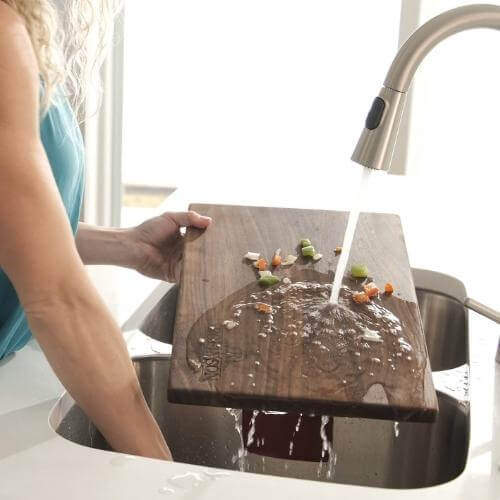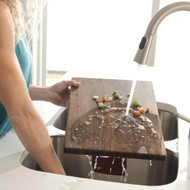How to Properly Clean Your Wood Cutting Board
Posted by Grant Chen on 17th Oct 2024
Properly knowing how to clean and maintain kitchen equipment has become somewhat of a lost art these days. Dirty dishes? Throw them in the dishwasher. Dull knives? Run them through an electric sharpener. Warped cutting board? Toss it and buy a new one. While throwing away a cutting board from the 99 cent store might be acceptable, the mere notion of throwing away a beautiful, hardwood cutting board due to lack of care should be grounds for the chef’s walk of shame.

The Three Rules of Cleaning: Clean, Disinfect and Dry
1) Clean
To clean using hot water, sponge and a light amount of soap, scrub off any foods and fluids that have come into touch with the board. Scientific evidence shows that in cleaning, the volume of water matters more than anything, as it washes away bacteria and particles, so make sure you run it under lots of water and especially on scarred sections that are good at trapping food particles.
2) Disinfect
To disinfect, use either pure white vinegar or a mixture of two tablespoons of chlorine bleach in a gallon of water. Note that any vinegar other than pure white vinegar may impart smells to your board that are undesired. These solutions work to disinfect the board because vinegar has a low pH and bleach has a high pH, both of which will kill bacteria and germs, as they can only live within certain pH conditions. To apply, soak a cloth in the solution, then wipe the board down thoroughly with the wet cloth.
If your board has any sour or mold-like smell, you can also put a cup of baking powder onto the board and pour a cup of white vinegar over the board. The combination of these two ingredients will create an oxidization process that will remove stains and (hopefully) any lingering smells left in your cutting board. For a more natural route, you can also cut lemons in half and rub the board down with the sides of the lemon. Let sit for a few minutes before rinsing off.
3) Dry
After you have disinfected your board, the most important part is to wipe it with a dry cloth. This last step is the most important for maintaining your cutting board, as water permeating the wood is what causes the wood fibers to swell and then warp your board. This is why you should
never soak your cutting board in water and never put it into the dish washer.
While not a part of cleaning, it’s always good practice after your board is dried to rub mineral oil onto your cutting board. Do not use other organic oils, as the fats in those oils can and will spoil, turning rancid and causing your cutting board to stink. One of the few natural oils that you can use is coconut oil, which will not go rancid for some time (but is not immune to eventually spoiling). Oils work by occupying the space in the wood fibers and preventing water from entering your board and causing cracks and splits. These little crevices are where bacteria love to hide and multiply, so preventing your board from having small fractures is the key to keeping your cutting board sanitary.
4) Recommended Products
CuttingBoard.com sells food safe cutting board oils that are FDA approved. You can pick up a bottle of John Boos Mystery Oil in a single bottle or by the pack, as it's recommended to oil your board every 3 to 4 weeks.
Things You Should Never Do
- Leave your cutting board soaking in water. The water will expand the wood fibers and crack the wood.
- Let blood pool on the wood for long periods so that it soaks in
- Put your cutting board into the dishwasher. The high heat and water is guaranteed to warp your board at best and split it in half at worst!
With only a few minutes of care, you can easily keep any cutting board in pristine condition for years to come, not to mention keep your prime working surface sanitary for you and your guests!

